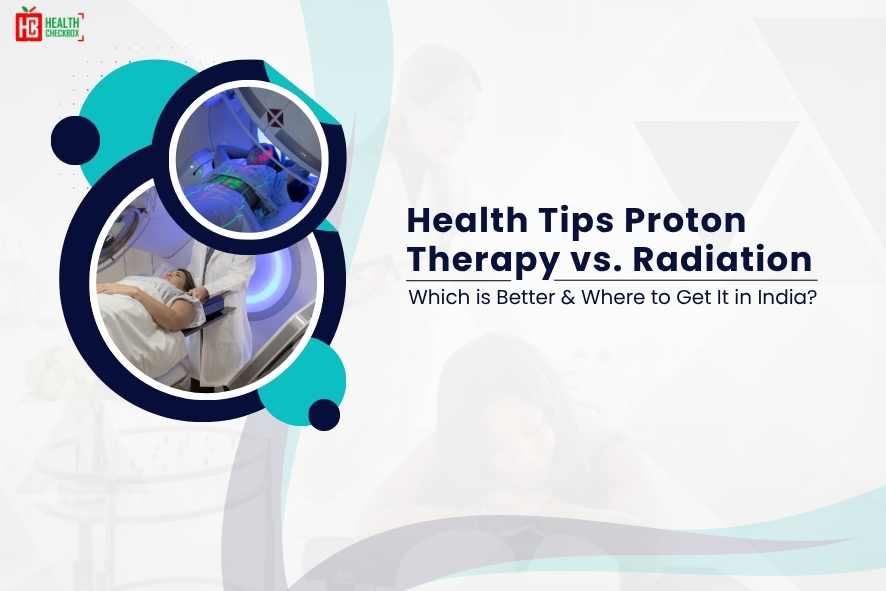Cancer treatment has become much easier to treat in days with help of various techniques. Today doctors can treat various kinds of tumors with the help of modern methods. High-energy rays are used in radiation therapies that are one of the most popular techniques to kill cancer cells. Proton therapy is a more modern and appropriate treatment option is currently becoming popular and more well-liked. Both treatment options aim to kill cancer cells. But the way they do it and their effects on the body are different. Here in this blog, we will get information on proton therapy vs. radiation therapy: which is better and where to get it in India.
The radiation technique is widely accessible and it has been used for many years in lung and brain cancer treatment. Although it is effective it may also damage healthy tissue in the tumors vicinity. Side effects are another possibility. Instead of X-rays, rays this technique involve protons to destroy cancerous tumors cells that are causing health-related difficulties in the body. Proton therapy more precisely targets the tumor and causes less harm to tumor areas and leave fewer adverse effects to the patient’s health. Children and tumors close to vital organs like the brain, spine, or eyes can benefit from this. In India, proton therapy is still new but is slowly becoming easier to get. A few top hospitals now offer this advanced treatment.
What is Radiation Therapy?
To treat cancer doctors frequently employ strong radiation such as gamma or X-rays. By destroying their DNA and stopping them from proliferating and dividing these rays aid in the destruction of cancerous cells. Both internal and external entry points are possible for these rays. The outcome depends on the type stage and affected area.
How Does Radiation Therapy Work?
The cellular processes of cancer cells are disrupted by ionizing radiation. The beams of high energy enter the body. and use the newest imaging methods such as CT or MRI scans to target the tumor. Maximizing damage to cancer cells while reducing harm to nearby healthy tissues is the aim. Nevertheless, because X-rays travel through the body they may have adverse effects on healthy tissues both before and after they reach the tumor.
Types of Radiation Therapy
- External Beam Radiation Therapy: This is the most prevalent therapy, where doctors destroys certain cancer developing cells through targeting radiation beams on the tumor from outside of the body with the help of certain medical tools or machines. Precision is improved by methods like Image-Guided Radiation Therapy (IGRT) and Intensity-Modulated Radiation Therapy (IMRT).
- Brachytherapy: It is a common treatment for treating various kinds of cancers including prostate and cervical cancer. It involves inserting radioactive sources inside to close to the tumor.
- Stereotactic Radiosurgery (SRS) and Stereotactic Body Radiation Therapy (SBRT): This type of therapy is apply by high radiation doses precisely on small and well-defined tumors that are usually found in the brain or lungs.
What is Proton Therapy?
This latest form of the disease is treated with protons rather than X-rays. With little effect on nearby tissues protons deliver their energy straight to the tumor site. Because proton therapy enables precise targeting it is especially appropriate for tumors in young patients or those close to delicate organs.
How Does Proton Therapy Work?
It involves accelerating protons to high speeds in a cyclotron or synchrotron and directing them at the tumor. The SOBP causes protons to release the majority of their energy at a particular depth. And stop abruptly rather than passing through the body. This precision reduces the dose of radiation to healthy tissues. And also lowers the risk of side effects. Advanced techniques like pencil beam scanning further enhance accuracy by shaping the proton beam to match the tumor’s contours.
Benefits of Radiation and Proton Therapy
- Numerous hospitals across India offer radiation therapy. Healthcare providers do not make proton therapy as widely available as radiation therapy due to its high cost and specialized equipment requirements.
- In general, radiotherapy is more cost-effective for physicians than proton therapy.
- Radiation therapy is proven to be effective for a variety of cancers, including breast, lung, and cervical cancers after decades of research and clinical use. However, brain tumors cancers in children and tumors close to vital organs like the heart or spine can also benefit from proton therapy.
- Experts in medicine believe it works well for a variety of cancer types and stages, and they frequently combine it with chemotherapy or surgery. Particularly in children the targeted nature of proton therapy lowers the long-term risk of radiation-induced cancers.
- Proton therapy provides up to 60% more healthy tissues than other therapies while delivering radiation directly to the tumor.
- Proton therapy often needs to use fewer fractions (sessions) than conventional radiation, thereby reducing treatment duration.
Limitations of Proton Therapy vs. Radiation Therapy
Despite being successful cancer treatments radiation and proton therapy have drawbacks. Side effects like exhaustion skin irritation or organ dysfunction can result from radiation therapys damage to the healthy tissues around tumors. Large irregularly shaped cancers or tumors that are resistant to radiation may lessen its effectiveness. Due to a lack of facilities proton therapy is more expensive and less accessible even though it is more accurate and causes less harm to healthy tissue. Not every type of cancer can be treated with it especially those that need broad radiation fields. Both treatments have a risk of long-term side effects such as secondary cancers and their effectiveness is influenced by the patients health tumor type and stage.
Availability of Proton Therapy and Radiation Therapy in India
Radiation therapy, including IMRT, IGRT, and stereotactic radiosurgery, is extensively available in both public and private hospitals in India. Leading cancer treatment facilities like Apollo Hospitals, AIIMS (Delhi), and Tata Memorial (Mumbai) offer cutting-edge radiation treatments. Although it is less invasive and more precise proton therapy is still available. Radiation therapy is available nationwide, but proton therapy is still pricy and only available in a few major cities. There are continuous expansion initiatives to boost availability.
Cost and Insurance Considerations
Cost and insurance are important considerations when it comes to healthcare or medical treatment. Insurance-uncovered services, co-payments, and deductibles are examples of out-of-pocket costs that can have a big influence on affordability. You should be aware of the things that your insurance plan will cover including prescription drugs doctor visits, and procedures. Avoiding unforeseen fees is crucial. Checking if providers are in-network is also crucial because out-of-network care typically has higher costs.
Applying for financial assistance programs or seeking care through community health centers can help those without insurance save money. Furthermore the kind of insurance may have an impact on coverage scope and accessibility. During enrollment periods comparing plans guarantees that people choose the most economical choice for their medical requirements. In the end patients are better able to make sustainable healthcare decisions when care quality and financial planning are balanced.
The cost of radiation therapy in private medical facilities can vary from INR 50000 to INR 260000 or 580 to 3000 USD depending on the method and duration of treatment. In addition the government medical sector provides qualified patients with discounted rates usually ranging from INR 20000 to INR 50000 (200 to 600 USD). The proton therapy costs between INR 1000000 and INR 3000000 or $12000 and $65000.
Which is Better: Proton Therapy vs. Radiation Therapy?
The choice between both two therapies depends on several factors:
- Cancer Type and Location: According to medical experts proton therapy is best for tumors treatment especially near by critical organs or in pediatric patients. Traditional radiation is versatile for most cancers treatments.
- Stage of Cancer: The precision of proton therapy is more advantageous for localized early-stage tumors, whereas the more comprehensive approach of traditional radiation may be necessary for advanced cancers.
- Patient Health and Age: Proton therapy reduces the risk of secondary cancers, which is advantageous for younger patients and those with longer life expediencies.
- Financial and Logistical Considerations: Many people find radiation therapy to be feasible due to its accessibility and affordability whereas proton therapy presents difficulties due to its high cost and scarcity of centers.
Conclusion
In India, proton and radiation therapy are essential cancer treatment options. Because of its affordable prices and broad accessibility. Demonstrated efficacy radiation therapy is a mainstay for the majority of patients. In contrast proton therapy’s accuracy reduces side effects and makes it perfect for tumors close to vital organs and pediatric patients, but its high cost and restricted availability present difficulties. Resources patient needs and cancer type all influence the decision. Equal access is getting better as India develops with new proton therapy facilities and government assistance. Make educated decisions for the best care by speaking with oncologists looking into financial aid and weighing the advantages of both treatments.

